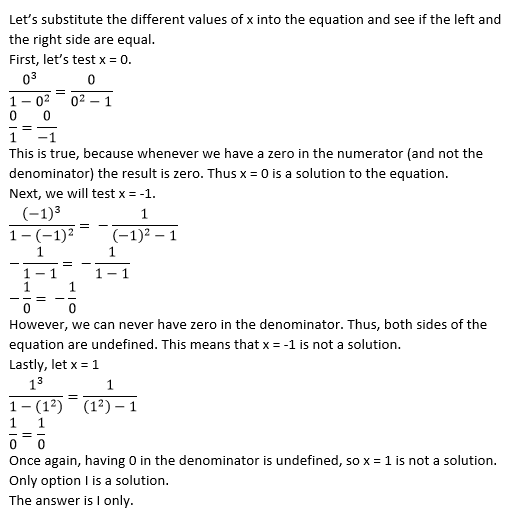All ACT Math Resources
Example Questions
Example Question #1 :How To Find Out When An Equation Has No Solution
Given the following system, find the solution:
x = y – 2
2x – 2y = 2
(1, 2)
(1, 1)
(0, 1)
(0, 0)
no solution
no solution
When 2 equations in a system have the same slopes, they will either have no solution or infinite solutions. Since the y-intercepts are not the same, there is no solution to this system.
Example Question #2 :How To Find Out When An Equation Has No Solution
Solve for
Infinite Solutions
No solution
No solution
Like other "solve for x" problems, to begin it, the goal is to get x by itself on one side of the equals sign. In this problem, before doing so, the imaginary -1 in front of (-27x+27) must be distributed.
Once this is done, you may start to try to get x by itself.
然而,当减去27 x从两侧doing the same on the other, the 27x term cancels out. As a result, the equation becomes:
We know this is an untrue statement because these numbers are 5 spaces away from each other on the number line. The final answer isNo Solution.
Example Question #3 :How To Find Out When An Equation Has No Solution
Given the following system, find the solution:
No solution
No solution
When two equations have the same slope, they will have either no solution or infinite solutions. By putting both equations into the form
and
With the equations in this form, we can see that they have the same slope, but different y-intercepts. Therefore, there is no solution to this system.
Example Question #4 :How To Find Out When An Equation Has No Solution
Solve the following equation for
No solution
Infinite solutions
No solution
In order to solve for

First, we can distribute the

When we try to get

We know this is an untrue statement, so there is no solution to this equation.
Example Question #1 :Linear / Rational / Variable Equations
Find the solution to the following equation if x = 3:
y = (4x2- 2)/(9 - x2)
6
3
0
no possible solution
no possible solution
Substituting 3 in for x, you will get 0 in the denominator of the fraction. It is not possible to have 0 be the denominator for a fraction so there is no possible solution to this equation.
Example Question #112 :Equations / Inequalities
There is no solution
3
–3
1
–1/2
There is no solution
Example Question #1 :How To Find Out When An Equation Has No Solution
None of the other answers
A fraction is considered undefined when the denominator equals 0. Set the denominator equal to zero and solve for the variable.
Example Question #21 :Algebra


No solutions.
No solutions.
Cross multiplying leaves
Example Question #111 :Linear / Rational / Variable Equations
I.x= 0
II.x= –1
III.x= 1
I, II, and III
I only
II and III only
III only
II only
I only
# 47例问题:Algebra
Solve:
First, distribute, making sure to watch for negatives.
Combine like terms.
Subtract 7x from both sides.
Add 18 on both sides and be careful adding integers.
All ACT Math Resources

























































